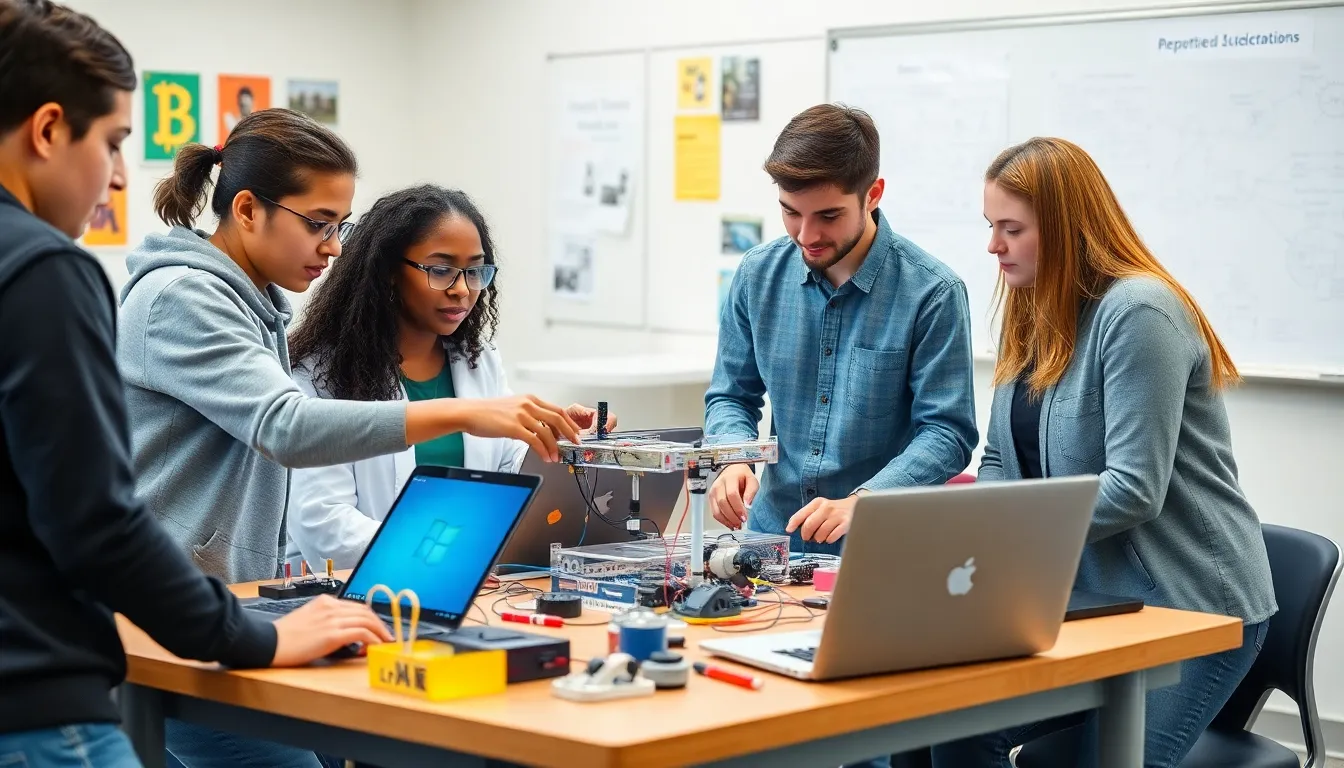STEM education is the secret sauce behind the world’s most innovative minds. From coding robots to launching rockets, it’s where creativity meets critical thinking. But let’s be honest: not all STEM examples are created equal. Some projects leave students inspired, while others… well, let’s just say they might prefer a nap instead.
STEM Education Examples
STEM education encompasses a broad range of disciplines including science, technology, engineering, and mathematics. Its primary goal is to prepare students for a rapidly evolving job market where technical skills are essential. Engaging in hands-on projects creates an interactive learning environment. Educators often use real-world problems to fuel curiosity and encourage exploration.
Experiential learning proves beneficial, as students apply theoretical concepts to practical situations. Collaborative activities foster teamwork, enhancing communication and critical thinking. Programs such as coding camps and robotics competitions cultivate technical expertise while developing problem-solving abilities.
In many schools, interdisciplinary approaches connect subjects to enhance understanding. Through these methods, students grasp how mathematics supports scientific inquiry or how engineering principles apply to technology. Engaging curriculum designs often include project-based learning, encouraging students to tackle challenges and innovate solutions.
The rise of online platforms offers another avenue for STEM education. Websites and apps provide resources for students to learn independently at their own pace. Virtual simulations also replicate complex scientific processes, making them accessible in an engaging format.
Research shows that early exposure to STEM concepts significantly influences student interest in these fields. Programs targeting younger students often employ engaging narratives that simplify complex ideas. Such strategies aim to inspire future scientists, engineers, and technological innovators, ensuring a skilled workforce for tomorrow’s challenges.
Importance of STEM Education

STEM education plays a crucial role in shaping the future workforce. This approach equips students with the necessary skills to thrive in a technology-driven world.
Skills Developed Through STEM
STEM education fosters critical thinking and problem-solving skills, essential for addressing complex challenges. Collaboration in projects enhances communication and teamwork, enabling students to work effectively with others. Creativity also flourishes as students explore innovative solutions to real-world problems. Students gain proficiency in data analysis and scientific inquiry, which prepares them for various tasks in multiple disciplines. Technical skills become a cornerstone, with hands-on experiences providing invaluable insights into practical applications. Adaptability is another crucial skill, as students learn to navigate new technologies and methodologies swiftly.
Career Opportunities in STEM Fields
Career opportunities in STEM fields are abundant and diverse. Industries actively seek individuals with STEM backgrounds, emphasizing the ongoing demand in sectors like healthcare, aerospace, and information technology. Jobs in engineering and computer science continue to grow rapidly, presenting numerous paths for graduates. Positions range from software developers to biomedical engineers, each offering unique challenges and rewards. Furthermore, roles in research and data analytics require sophisticated skills, making candidates with STEM education particularly desirable. Employers recognize the value of knowledge in technology and innovation, driving increased investment in STEM-related positions.
Notable STEM Education Examples
Various programs across schools and communities showcase effective STEM education. These initiatives inspire engagement and foster skills crucial for future jobs.
Programs in Schools
Numerous schools implement innovative STEM programs, enhancing student learning. For example, Project Lead The Way integrates hands-on activities and real-world projects, encouraging creative thinking. Additionally, robotics competitions, like FIRST Robotics, allow students to design and program robots. Incorporating coding in elementary curricula also sparks interest in technology, with tools like Scratch introducing programming fundamentals. These programs demonstrate the importance of practical applications, ensuring students connect theory with tangible results.
Community-Based Initiatives
Several community-based initiatives promote STEM education beyond schools. Organizations like Girls Who Code aim to close the gender gap in technology fields through coding clubs and summer camps. Local libraries often host STEM workshops that engage children and parents alike, creating a community of learners. Additionally, science fairs encourage students to showcase their projects, building confidence and presentation skills. These initiatives highlight the collaborative effort to foster a strong foundation in STEM, ensuring diverse opportunities for all learners.
Innovative STEM Projects
Innovative STEM projects engage students creatively and practically, allowing them to explore complex concepts effectively.
Makerspaces and Fab Labs
Makerspaces and Fab Labs offer hands-on learning environments. They provide students with tools and resources to design and create projects. Access to 3D printers, laser cutters, and electronics kits allows for experimentation. Collaboration among peers fosters teamwork while tackling real-world challenges. Students develop critical problem-solving skills and creative thinking as they work on projects like robotics or prototype design. Numerous schools and community centers have established these spaces, reinforcing the importance of innovation in education.
Online STEM Resources
Online STEM resources support independent learning and enhance student engagement. Platforms like Khan Academy, Code.org, and robotics-focused websites provide comprehensive materials. They offer tutorials, interactive lessons, and project ideas to ignite interest. Students can learn coding, data analysis, and engineering concepts at their own pace. Accessing diverse resources can also bridge gaps in traditional classroom instruction. The flexibility of online tools enables learners to explore STEM topics outside the confines of school, allowing them to develop necessary skills for future careers.
Conclusion
STEM education stands as a vital pillar for preparing students for the challenges of tomorrow. By engaging learners in hands-on projects and innovative programs, it cultivates essential skills that extend beyond the classroom. The collaborative efforts of schools and communities to promote STEM initiatives ensure that students from diverse backgrounds can access these opportunities.
As technology continues to evolve, the demand for skilled professionals in STEM fields will only grow. Embracing a comprehensive approach to STEM education not only enhances student engagement but also equips the future workforce with the tools needed to thrive in an increasingly complex world. Investing in STEM today paves the way for a more innovative and capable tomorrow.

